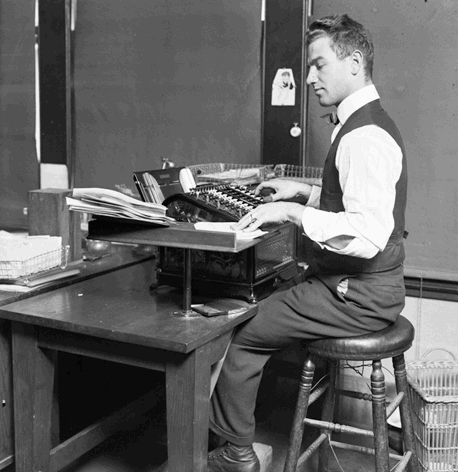
We are millions. With our screens on a desk or lap, or in hand, we sit for long periods enduring degrees of discomfort ranging from a mild urge to shift our bottoms to extreme pain in neck, back or arms. As we transitioned from pen and pad, through typewriter and copystand, to the keyboard and monitor, attention centred initially on screen positioning. Some arbitrary notions that resulted, such as the elevation of the monitor above the head, or having it distanced precisely at arm’s length from the face, were interesting for their quaint reversion to Medieval standard measures (as when a foot measure was roughly the length of a man’s) but which failed to help with the aches and pains. Later, attention shifted to the seating, attracting state of the art science garnered from various fields, and collectively known as ergonomics
We have trawled through the saddle seat and the kneeling chair, the pelvic girdle and the bouncing ball, culminating in the complex office chair with its manifold possibilities for questionable ‘adjustment to the human form’, none of them ridding us of sitting-induced back pain. I often wonder how many of these experts sit comfortably on their own appliances? You can hardly call them chairs any longer. They have transmuted into symbols of serious business, work; in the same way that the necktie tells us the wearer is skilled and delivers information. Designing a badly-shaped chair to fit a poorly–shaped body compounds the problems of both. When a well-shaped person sits on a badly-shaped chair – one that has been constructed in conformation with normal bad posture - the tougher material wins, as the biological is more readily corrupted.
We have tried posture correction, massage and idiosyncratic exercise to no long-term avail, while the latest school of thought seems to have given up on sitting altogether, advocating standing instead. Dotted amongst the slumped beavers we now see one or two people standing, looking like meerkats on watch.
Yes, sitting can be harmful, but so can standing if you’re doing it badly. From amidst the multiple applications to this universal area of human suffering, F M Alexander alone has crucially linked both environment and posture in looking at both what we are sitting ON and HOW we are sitting on it.
Whether it’s good or bad for us, standing also depends on HOW we are doing so, whether we are using gravity to our advantage or otherwise. The common stance where the trunk is collapsed – ‘relaxed’ - thrusting the pelvis forwards and driving unsprung weight onto mal-aligned joints, is what Alexander called ‘pulling down’. When we pull ourselves down, the body’s natural opened out shaping is spoiled, causing compensatory muscle tension in stressful holding patterns.
When we work out at the gym deploying these same ‘core muscles’ we compound the harm.
Good deportment in both standing and sitting is a matter of deploying the inbuilt physiological mechanisms for optimizing reflex muscle response that hold the trunk upright and expanded - in F M Alexander’s words ‘lengthened and widened’ - and in standing, getting the trunk to extend from the legs. In sitting, the pelvis needs to be upright, balanced on the ischial tuberosities, to give the base of the spine where it’s attached to the sacrum, the best orientation for balancing the head freely on the lengthened out spine. Look at an infant sitting on a firm flat surface and you see all there is to know about perfect poise. Put the same child on a canted seat and watch how a normal adult sitting shape appears as the child’s pelvis is tipped backwards bringing the lumbar spine with it and necessitating a tightening and pulling down in front. In this situation, the body is forced to counterbalance the backwards pull by overworking the flexors in order to hold itself upright on the chair. Don’t we all instantly recognize the discomfort of the plastic moulded chair?
The logical answer therefore would appear to be simply to hold yourself upright on a flat seat. True, but like most things in life, the business is more complex – and it took the genius of F M Alexander to work out why direct instructions to ‘sit up’, ‘hold your core’ etc. don’t work in a body whose shape has deteriorated. From where we are in adult life with assorted bodily damage, simply switching to suitable furniture will not do much for us without thorough re-education as well. Sit a poorly-shaped person on a good chair and he will be in there with a chance, as a good chair gives appropriate support. But the sitter also needs to re-learn HOW to sit well on it.
Thanks to F M Alexander’s genius we do have a method for addressing this universal need. The Alexander Technique is an educative process rather than a treatment, requiring good guidance and time to grow understanding through experience. With an Alexander Technique teacher, you learn improved use of the self, incorporating a refinement of proprioception and appropriate relation to the environment in which the individual deploys his restored sense of balance and movement.
Christine Ackers is the founder of ATE Inc. and has been teaching the Alexander Technique for 45 years. She trained with Dilys and Walter Carrington and runs her own teacher training course in Sydney, Australia.
